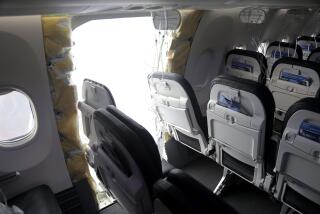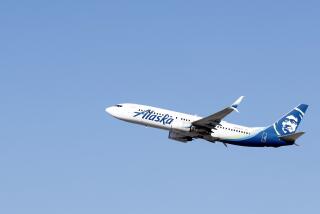Pilots Ask U.S. to Look at Airbus Groundings
WASHINGTON â American Airlines pilots have told the government it should consider grounding the Airbus A300-600, one of which crashed in New York last year, because of safety questions.
American Airlines and Airbus Industrie say the plane is safe. The Federal Aviation Administration has ordered new inspections of Airbus A300-600s but has not ordered the grounding of the aircraft.
In a report submitted this week to the FAA and the National Transportation Safety Board, Americanâs pilots concluded: âSerious consideration must be given to grounding the entire A300-600 fleet until its airworthiness can be assured.â
Eight pilots signed a letter accompanying the report, a copy of which was obtained by Associated Press. The pilots presented the report Wednesday to their union, the Allied Pilots Assn., which has not endorsed the recommendations. Union representatives are helping the safety boardâs investigation of the Nov. 12 crash, which killed 265 people.
Some American pilots in January signed an e-mail petition asking the company to ground the Airbus, but the effort failed. This is the first time pilots have taken their request to the federal government. In their letter, they attached the results of a two-month study analyzing safety issues surrounding the plane.
âThe flying public must have assurances that every aircraft they board is designed and maintained to the highest standards,â the pilots said.
Safety board spokesman Ted Lopatkiewicz said the agency had received the report and would respond to it. FAA spokesman Les Dorr also said the report would be reviewed.
American Flight 587 experienced several sharp side-to-side movements before its tail fell off and the plane crashed shortly after taking off from John F. Kennedy International Airport. The FAA earlier this month ordered inspections of A300-600 and A310 planes that experience similar movements. Both planes have tails made of nonmetallic composite materials.
In addition, tails of A300-600s that have hit turbulence in the past or had sharp rudder movements underwent ultrasound inspections. American checked two planes and found no damage.
The inspections came after safety board investigators found previously undetected damage to the tail of an American Airbus that swayed while trying to land at West Palm Beach Airport in Florida, in May 1997. Two people were injured.
The Airbus that crashed in November had been severely shaken by air turbulence in November 1994 while flying from Barbados to Puerto Rico, injuring 47 people, federal investigators said.
In addition, the planeâs tail hit the runway while landing at Montego Bay, Jamaica, in December 1997, safety board records show. No one was injured.
Dorr said future ultrasound inspections would depend on new evidence, because taking off the tail could cause damage to the plane.
In their report, the pilots called for reviewing the process for certifying composite parts and for redesigning the rudders. They said there have been several instances when the Airbus rudders moved on their own.
In a statement, American Airlines noted that only eight of its 400 Airbus pilots signed the latest letter, and said no one has refused to fly the plane. âIf they donât think the Airbus is airworthy, why are they still flying it?â the airline statement asked.
Airbus officials have said tests show that damage that canât be seen cannot weaken the tail, and company spokeswoman Mary Anne Greczyn said the safety boardâs investigation has not found any safety problems with the plane. âThe A300 was and remains a safe aircraft,â she said.
During the probe, board investigators discovered that moving a planeâs rudder in one direction, followed by a sharp movement in the other direction, could break off the tail fin. The safety board issued such a warning last month.
More to Read
Inside the business of entertainment
The Wide Shot brings you news, analysis and insights on everything from streaming wars to production â and what it all means for the future.
You may occasionally receive promotional content from the Los Angeles Times.










